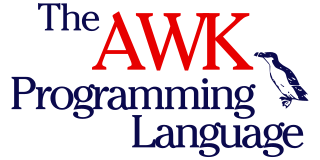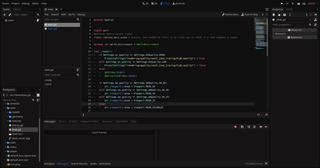
AWK (awk) is a domain-specific language designed for text processing and typically used as a data extraction and reporting tool. Like sed and grep, it is a filter, and is a standard feature of most Unix-like operating systems.

Bash is a Unix shell and command language written by Brian Fox for the GNU Project as a free software replacement for the Bourne shell. First released in 1989, it has been used as the default login shell for most Linux distributions. Bash was one of the first programs Linus Torvalds ported to Linux, alongside GCC. A version is also available for Windows 10 and Windows 11 via the Windows Subsystem for Linux. It is also the default user shell in Solaris 11. Bash was also the default shell in versions of Apple macOS from 10.3 to 10.15, which changed the default shell to zsh, although Bash remains available as an alternative shell.

A shell script is a computer program designed to be run by a Unix shell, a command-line interpreter. The various dialects of shell scripts are considered to be scripting languages. Typical operations performed by shell scripts include file manipulation, program execution, and printing text. A script which sets up the environment, runs the program, and does any necessary cleanup or logging, is called a wrapper.

A Unix shell is a command-line interpreter or shell that provides a command line user interface for Unix-like operating systems. The shell is both an interactive command language and a scripting language, and is used by the operating system to control the execution of the system using shell scripts.

The C shell is a Unix shell created by Bill Joy while he was a graduate student at University of California, Berkeley in the late 1970s. It has been widely distributed, beginning with the 2BSD release of the Berkeley Software Distribution (BSD) which Joy first distributed in 1978. Other early contributors to the ideas or the code were Michael Ubell, Eric Allman, Mike O'Brien and Jim Kulp.
A filename extension, file name extension or file extension is a suffix to the name of a computer file. The extension indicates a characteristic of the file contents or its intended use. A filename extension is typically delimited from the rest of the filename with a full stop (period), but in some systems it is separated with spaces. Other extension formats include dashes and/or underscores on early versions of Linux and some versions of IBM AIX.

The cd command, also known as chdir, is a command-line shell command used to change the current working directory in various operating systems. It can be used in shell scripts and batch files.
Almquist shell is a lightweight Unix shell originally written by Kenneth Almquist in the late 1980s. Initially a clone of the System V.4 variant of the Bourne shell, it replaced the original Bourne shell in the BSD versions of Unix released in the early 1990s.
In computer programming, glob patterns specify sets of filenames with wildcard characters. For example, the Unix Bash shell command mv *.txt textfiles/ moves all files with names ending in .txt from the current directory to the directory textfiles. Here, * is a wildcard standing for "any string of characters except /" and *.txt is a glob pattern. The other common wildcard is the question mark (?), which stands for one character. For example, mv ?.txt shorttextfiles/ will move all files named with a single character followed by .txt from the current directory to directory shorttextfiles, while ??.txt would match all files whose name consists of 2 characters followed by .txt.

A command shell is a command-line interface to interact with and manipulate a computer's operating system.
env is a shell command for Unix and Unix-like operating systems. It is used to either print a list of environment variables or run another utility in an altered environment without having to modify the currently existing environment. Using env, variables may be added or removed, and existing variables may be changed by assigning new values to them.
In computing, a shebang is the character sequence consisting of the characters number sign and exclamation mark at the beginning of a script. It is also called sharp-exclamation, sha-bang, hashbang, pound-bang, or hash-pling.
binfmt_misc is a capability of the Linux kernel which allows arbitrary executable file formats to be recognized and passed to certain user space applications, such as emulators and virtual machines. It is one of a number of binary format handlers in the kernel that are involved in preparing a user-space program to run.
The script command is a Unix utility that records a terminal session. It dates back to the 1979 3.0 BSD.

A scripting language or script language is a programming language that is used to manipulate, customize, and automate the facilities of an existing system. Scripting languages are usually interpreted at runtime rather than compiled.
In a Unix shell, the full stop called the dot command (.) is a command that evaluates commands in a computer file in the current execution context. In C Shell, a similar functionality is provided as the source command, and this name is seen in "extended" POSIX shells as well.
In computing, command substitution is a facility that allows a command to be run and its output to be pasted back on the command line as arguments to another command. Command substitution first appeared in the Bourne shell, introduced with Version 7 Unix in 1979, and has remained a characteristic of all later Unix shells. The feature has since been adopted in other programming languages as well, including Perl, PHP, Ruby and Microsoft's Powershell under Windows. It also appears in Microsoft's CMD.EXE in the FOR command and the ( ) command.

A command-line interpreter or command-line processor uses a command-line interface (CLI) to receive commands from a user in the form of lines of text. This provides a means of setting parameters for the environment, invoking executables and providing information to them as to what actions they are to perform. In some cases the invocation is conditional based on conditions established by the user or previous executables. Such access was first provided by computer terminals starting in the mid-1960s. This provided an interactive environment not available with punched cards or other input methods.
The following outline is provided as an overview of and topical guide to the Perl programming language:
shc is a shell script compiler for Unix-like operating systems written in the C programming language. The Shell Script Compiler (SHC) encodes and encrypts shell scripts into executable binaries. Compiling shell scripts into binaries provides protection against accidental changes and source code modification, and is a way of hiding shell script source code.






